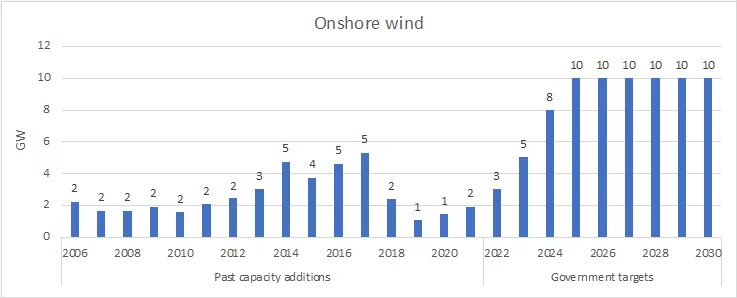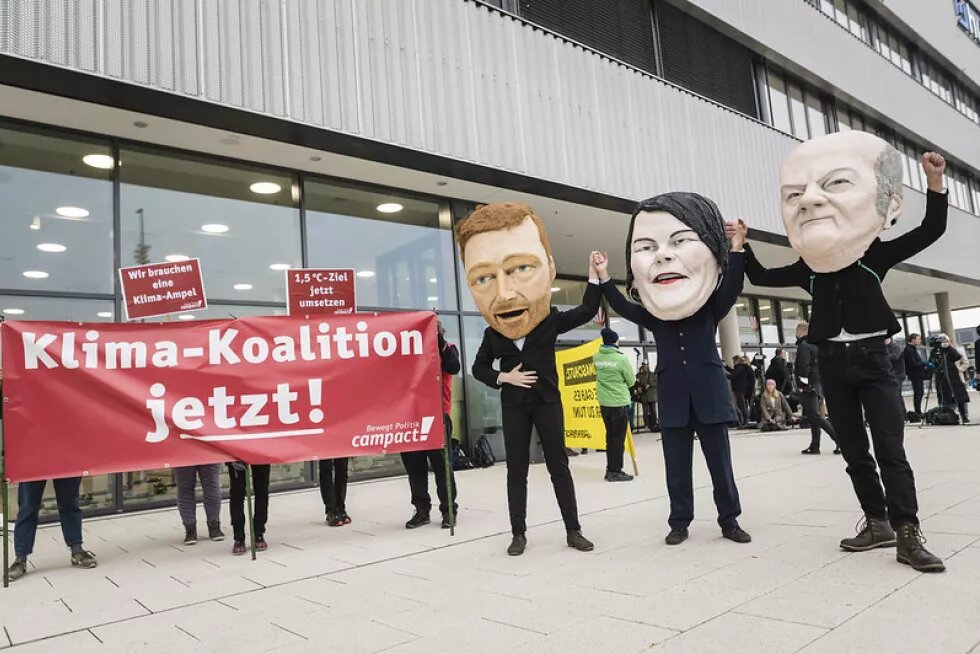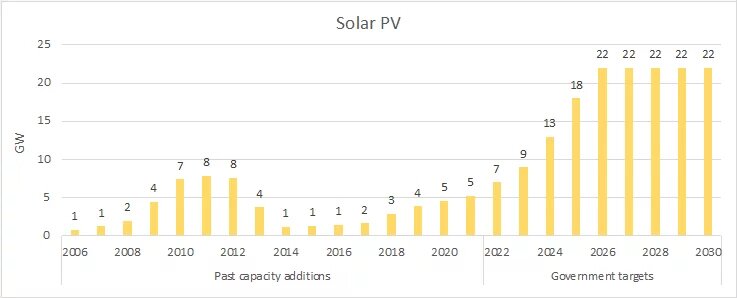
Germany aims to cut greenhouse gas emissions and achieve climate neutrality by 2045. The country's "Traffic-Light government", in power since December 2021, prioritizes accelerating the Energiewende—transforming the energy system towards renewables and efficiency. This Spotlight examines the government's plans, now more urgent due to fossil fuel price hikes and supply concerns following Russia's invasion of Ukraine.

Introduction
Germany has ambitious targets to drastically cut its greenhouse gas emissions in the coming years and to achieve climate neutrality by 2045. To be able to achieve these goals, the transformation of the German energy system towards renewable energy sources and more energy efficiency (the ‘Energiewende’) will need to accelerate considerably. In December 2021, a new German government came into power and the three parties that form this coalition have promised to achieve much faster progress in the Energiewende and to make this a top priority in the coming years. This Spotlight takes a closer look at the German government’s plans announced so far to move forward the Energiewende, a task that has become even more urgent in light of the fossil fuel price increases and security of supply concerns that followed Russia’s invasion of Ukraine in February 2022.
Background
In the German federal election of September 2021, the Social Democrats (SPD) won just over one fourth of the votes, more than any other single party. This allowed Olaf Scholz, the party’s frontrunner, to form a new three-party government consisting of his Social Democrats, the Greens and the Free Democratic Party (FDP). In December 2021, Scholz became the new German Chancellor, replacing Angela Merkel from the Christian Democratic Union (CDU), who had been in power for 16 consecutive years. In their coalition agreement, the three parties identified a faster reduction of greenhouse gases and an accelerated ‘Energiewende’ as key goals of their new government.
In past years, Germany’s energy transition has been too slow to be able to achieve the country’ mid- and long-term climate targets. A government-commissioned study found in 2021 that without additional policy measures, Germany was likely to miss its 2030 greenhouse gas emissions reduction target. Instead of the government’s target of achieving at least a 65 % reduction in emissions by 2030 relative to 1990, the study expects emissions to be reduced by only 49 % by then. Energy efficiency improvements have not been sufficient in recent years, and progress in deploying additional wind and solar power plants has been too low compared to what is needed for Germany to achieve its climate targets.
Against this backdrop of ambitious climate protections targets on the one hand and insufficient progress in many areas of the ‘Energiewende’ on the other hand, the new government has promised to enact additional measures in all relevant areas of the ‘Energiewende’ so as to bring Germany back on track to reach its greenhouse gas emission reduction targets. In the next Section, this Spotlight will introduce some of the key measures that the new government has announced to implement in the coming months and years to achieve an acceleration of the ‘Energiewende’.
Climate and energy policy intentions of the new government
Renewables in electricity generation
The new government and especially its minister for economic affairs and climate action, Robert Habeck from the Greens, has repeatably stressed the importance for the success of the Energiewende of significantly accelerating the deployment of wind power and solar PV. Consequently, changes in the key legislation to support the expansion of renewables, the Renewable Energy Sources Act (Erneuerbare-Energien-Gesetz, EEG), are being pursued by the government with high priority. A draft bill of the planned amendment of the EEG was adopted by the Federal Cabinet in early April 2022, as part of the so called ‘Easter Package’, a set of revisions to several energy laws. The draft EEG bill sets more ambitious targets for the expansion of renewables. It intends to reach a share of renewables of 80 % (previously the target was 65 %) in gross electricity consumption by 2030. Already by 2035 the electricity supply in Germany is to be based ‘almost entirely’ on renewables. However, the coalition partner FDP stated that it does not regard this 2035 target to be realistic and that it intends to achieve some changes to the law before it is finally passed in parliament.
To achieve the envisioned strong increase in the share of renewables by 2030, the draft bill sets technology-specific expansion targets for onshore wind power and solar PV. The installed capacity of onshore wind power is supposed to more than double from its 2021 level (56 GW) to 2030 (115 GW). The installed solar PV capacity is supposed to even more than triple until 2030, from 59 GW in 2021 to 215 GW in 2030.
To achieve these installed capacities by 2030, the annual expansion of solar PV and onshore wind power plants will need to grow four- to fivefold by the second half of this decade compared to the past few years (see Figure 1). A number of legislative changes are intended to make such an accelerated expansion possible: The annual tender volumes of large-scale PV plants and onshore wind plants will be greatly increased, allowing more investors to receive support for new installations. At the same time, remuneration rates for smaller scale PV roof systems will be increased. The new EEG also intends to offer specific remuneration rates for additional types of PV plants (for example for so called ‘agrivoltaics’ plants operated above soils used for agriculture).
Sources: Based on data from Bundesverband WindEnergie (2022), Fraunhofer ISE (2022), Federal Ministry of Economic Affairs and Climate Action (2022)
Furthermore, the draft amendment of the EEG now stipulates the principle that the use of renewables is ‘in the overriding public interest and serves public safety’. This is intended to strengthen the position of investors that may face legal challenges against their wind or PV projects. In addition, the new EEG intends to make it easier for small-scale investors including citizen cooperatives to invest in new plants, as wind projects up to 18 MW and ground-mounted solar projects up to 6 MW will no longer need to take part in the auctions but will receive fixed remuneration rates for the electricity they produce.
The government hopes that this amendment will lead to more investments from citizens and local investors as it increases their investment security and reduces their bureaucratic burdens. This is also intended to increase public acceptance for the further expansions of wind and solar power. The draft version of the new EEG also intends to offer more opportunities for local communities to receive financial support from operators of renewable energy plants, which is also intended to foster local support for the construction of additional renewable energy plants.
A key barrier for an increased expansion of onshore wind power plants has been a lack of land for new projects. In order to provide more space for these plants, the federal government is currently in exchange with governments of the 16 federal states, some of which have minimum distance requirements for wind turbines in place that severely restrict the areas suitable for wind power development.
The new government also plans to accelerate the expansion of offshore wind power in the coming years and decades. In the draft revision of the Offshore Wind Energy Act, it is now aiming for an installed capacity of at least 30 GW by 2030 (instead of the previous 20 GW), at least 40 GW by 2035 und at least 70 GW by 2045. To this end, the government will increase the annual tender volumes for new projects and will simplify the procedures for their construction, hoping to significantly shorten the implementation period of new offshore wind farms.
Phase-out of electricity generation from coal
The previous government announced in 2019 to aim for a phase-out of electricity generation from coal by 2038 at the latest, with 2035 as a possible earlier phase out date. A much earlier phase-out had been demanded by the Greens during the election campaign and was a key issue for the party in the coalition negotiations. As stated in the coalition agreement, the new government is now aiming for a coal phase-out ‘ideally by 2030’ and intends to review the coal phase-out date already in 2022. (In the current coal phase-out legislation, the next review of the phase-out date is not planned until 2026.) The government says it is taking the ‘necessary steps’ to enable a coal phase-out by 2030.
Hydrogen production and hydrogen imports
The new government points out that green hydrogen is a central component for achieving Germany’s climate targets. It aims to have 10 GW of electrolyser capacity installed by 2030, twice the capacity aimed for by the previous government. This is to be achieved mainly through the implementation of the hydrogen projects in the framework of the ‘Important Projects of Common European Interest’ as well as the establishment of further support programs such as Carbon Contracts for Difference. Details regarding these further support programs have not yet been announced by the government. As Germany is not expected to be able to meet all its future hydrogen demand from domestic production, the government intends to lay the groundwork for future imports of green hydrogen, for example by initiating international energy partnerships and by supporting the H2Global initiative, which financially supports early international trading in green hydrogen.
Transport sector
In its coalition agreement, the new government set a more ambitious target for the number of electric vehicles to be in operation in Germany by 2030. It aims for 15 million fully-electric cars by then. The previous government’s 2030 target was 10 million cars, and unlike the current target this included plug-in electric cars. The new government expects that in order to achieve this target, the share of fully electric cars in overall car sales will need to reach 85 % by 2030. It states that additional measures are needed as without such additional measures, the share is expected to reach only some 40 % by 2030. No specific measures have been announced yet, but the government intends to reform the current subsidy for electric cars at the beginning of 2023 in such a way that from then on only vehicles ‘that have a demonstrable positive climate protection effect’ will be subsidized.
According to the coalition agreement, the new government also intends to double the passenger transport volume of rail traffic by 2030. No specific plans on how to achieve such a strong increase in the use of public transport have been announced yet.
Space heating
Space heating in buildings makes up more than one fourth of Germany’s total final energy demand and is currently based mostly on fossil fuels. The government therefore sees improvements in the efficiency of existing buildings as a key lever to reduce CO2 emissions and intents to achieve a doubling in the rate of annual energy-efficiency improving retro-fits of existing buildings by 2030. It states that public buildings must set an example in regard to enacting retrofitting measures that drastically reduce space heating demand. Furthermore, the new government has set a new target of reaching a 50 % share of renewables in heating by 2030. The share of renewables in heating has increased only marginally in recent years and was at 16.5% in 2021. In order to achieve the 50 % share by 2030, the government intends to mandate that from 2024 on each new heating system will need to be based to at least 65 % on renewable energy sources, which is expected to provide a huge boost for the installation of heat pumps. The government also intends to support the expansion of renewables-based local heat grids. Specific legislative proposals on these measures have not yet been laid forth by the government.
Industry sector
The new government states that a ‘fundamental transformation of industrial production processes’ needs to take place in order for the sector to be able to reach its emission reduction targets and move towards climate neutrality by 2045. The government mentions electrification, energy and resource efficiency, and a circular economy as key elements of this transformation. It also states that existing support mechanisms for emission reduction measures (such as the European Emissions Trading System) are ‘by far not enough’ to achieve the desired emission reductions in the sector.
The government mentions two specific instruments that are to complement existing instruments in the industry sector: Already at the beginning of the legislative period, the government intends to create the legal and financial preconditions for the provision of Carbon Contracts for Difference as a central instrument to support transformation in industry. Such contracts would allow companies in energy-intensive branches to invest in more expensive but climate friendly production processes by providing sufficient investment security. Through such contracts, the government would compensate companies over a certain period of time for the extra costs of investing into and operating the new processes. A pilot phase for these Contracts for Difference is expected to be initiated soon. In addition, the use of climate-friendly technologies in the industry sector is also announced to be supported through improved tax write-off options (so called ‘super depreciations’), but as in the case of the Contracts for Difference, no details have been announced as of mid-April 2022.
CO2 pricing
In its coalition agreement, the new government states that, if necessary, it will introduce a minimum price for CO2 emissions covered by the EU Emissions Trading System on the national level. It intends to prevent a CO2 price of less than 60 EUR per ton. However, the government prefers an agreement on a minimum price on the European level. Regarding the CO2 prices introduced in Germany by the previous government for the use of fossil fuels in transport and heating, the coalition agreement states that the (rather moderate) price increases foreseen in the coming years will not be adjusted upwards due to the high current fossil fuel prices.
Outlook
The Easter Package containing draft amendments to the EEG, the Offshore Wind Energy Act and several other energy laws was adopted by the German cabinet in early April 2022. It was about to enter the parliamentary legislative procedure at the time of writing (mid-April 2022). The Ministry for Economic Affairs and Climate Action announced that it will introduce an additional ‘Summer Package’ before by the middle of the year. This package will include revisions of additional energy laws. It is expected that specific measures to increase the land available for new onshore wind plants will be among the issues to be addressed by this package. The ministry intends to finalize the legislative process for all energy law amendments by the end of 2022.
It will be interesting to see in the coming months how the government’s specific proposals for addressing many of the key ‘Energiewende’ issues will look like. This includes measures to accelerate the annual energetic renovation rate of buildings, fast-track the replacement of heating systems, further increase the share of fully electric cars in overall car sales, introduce a pilot program for Contracts for Difference in the industry sector and to stimulate the ramp-up of green hydrogen production.
Ideological differences between the three coalition parties may still lead to prolonged discussions of draft legislation between the different departments of the government. Particularly the two smaller parties, the Green Party and the Free Democratic Party, generally have diverging views on the government’s role in the transformation process. While the Green Party supports a broad mix of climate policy measures in the various sectors of the energy system, the Free Democrats prefer to rely to a large extent on a CO2 price signal for steering the transformation process.
Further reading
Federal Ministry of Economic Affairs and Climate Action (2022): Germany’s current climate action status. https://www.bmwi.de/Redaktion/EN/Downloads/E/germany-s-current-climate-action-status.pdf?__blob=publicationFile&v=11.
Federal Ministry of Economic Affairs and Climate Action (2022): Overview of the Easter Package. https://www.bmwi.de/Redaktion/EN/Downloads/Energy/0406_ueberblickspapier_osterpaket_en.pdf?__blob=publicationFile&v=5.
Federal Ministry for Economic Affairs and Energy (2021): The Energy of the Future 8th Monitoring Report on the Energy Transition – Reporting Years 2018 and 2019. https://www.bmwi.de/Redaktion/EN/Publikationen/Energie/the-energy-of-the-future-8th-monitoring-report.pdf?__blob=publicationFile&v=6.
Prognos, Öko-Institut, Wuppertal Institute (2021): Towards a Climate-Neutral Germany by 2045 – How Germany can reach its climate targets before 2050. https://static.agora-energiewende.de/fileadmin/Projekte/2021/2021_04_KNDE45/A-EW_213_KNDE2045_Summary_EN_WEB.pdf.
The opinions expressed in this text are solely that of the author/s and do not necessarily reflect the views of the Heinrich Böll Stiftung Tel Aviv and/or its partners.



